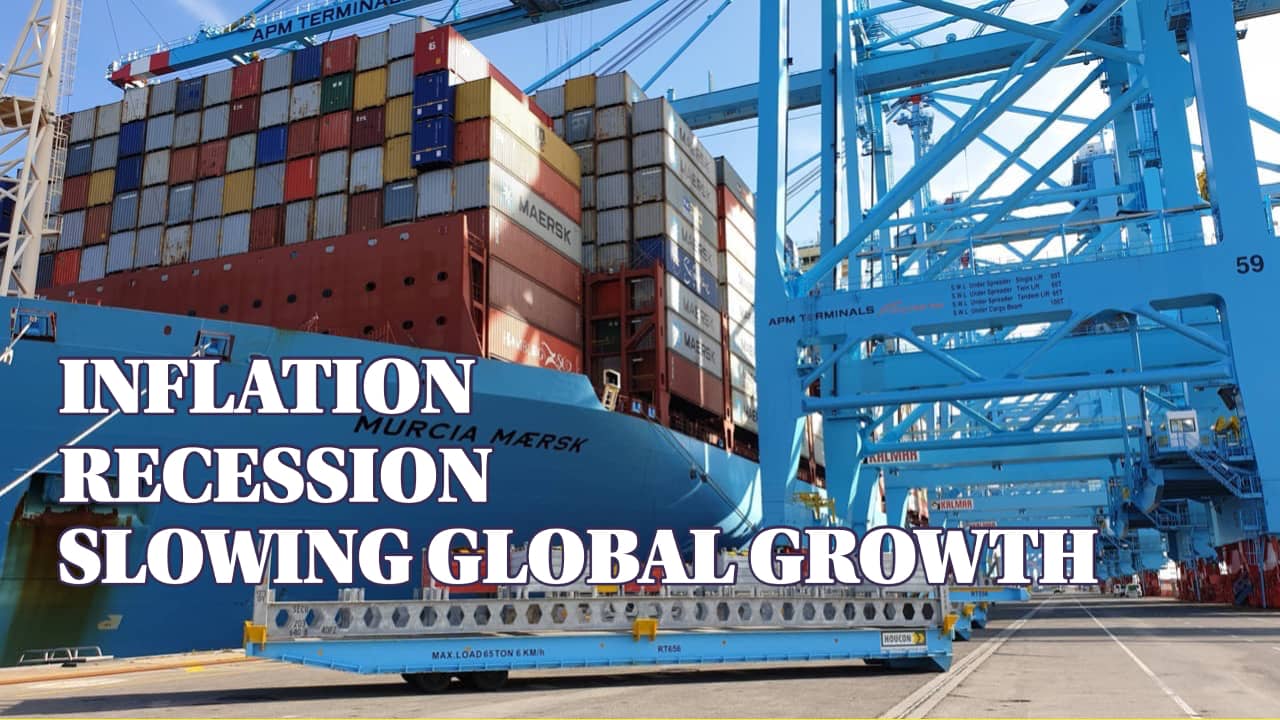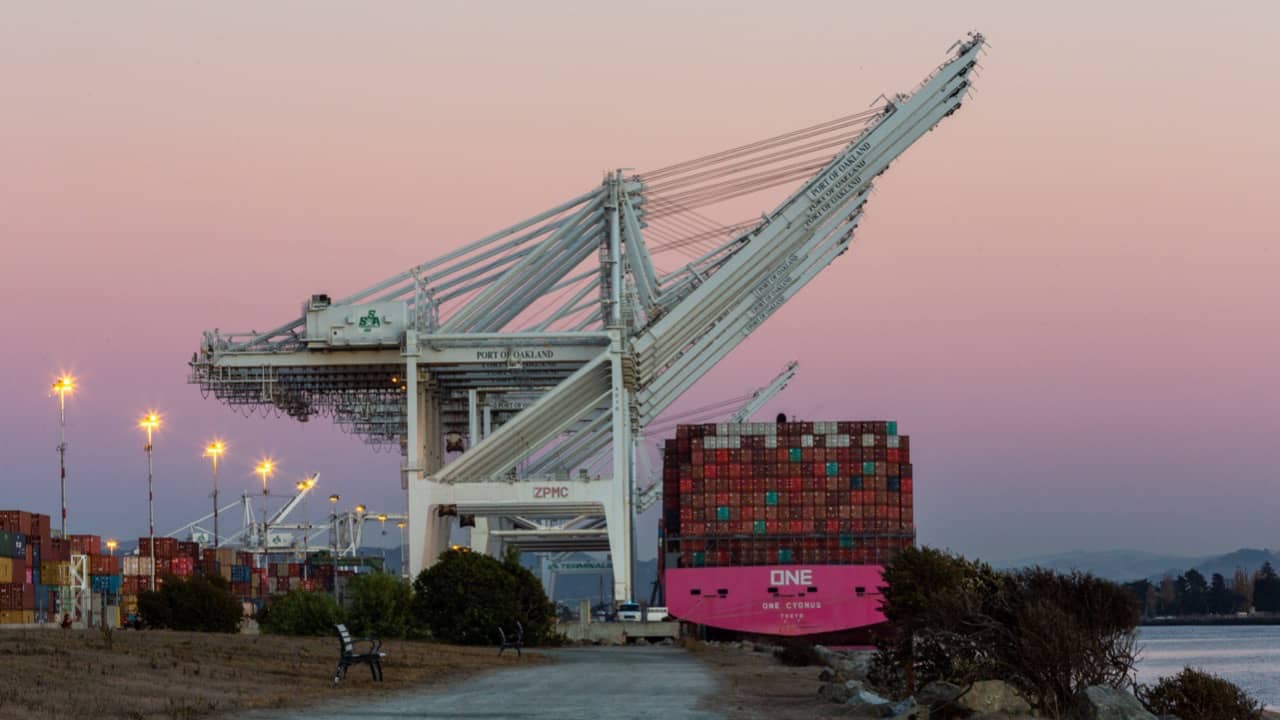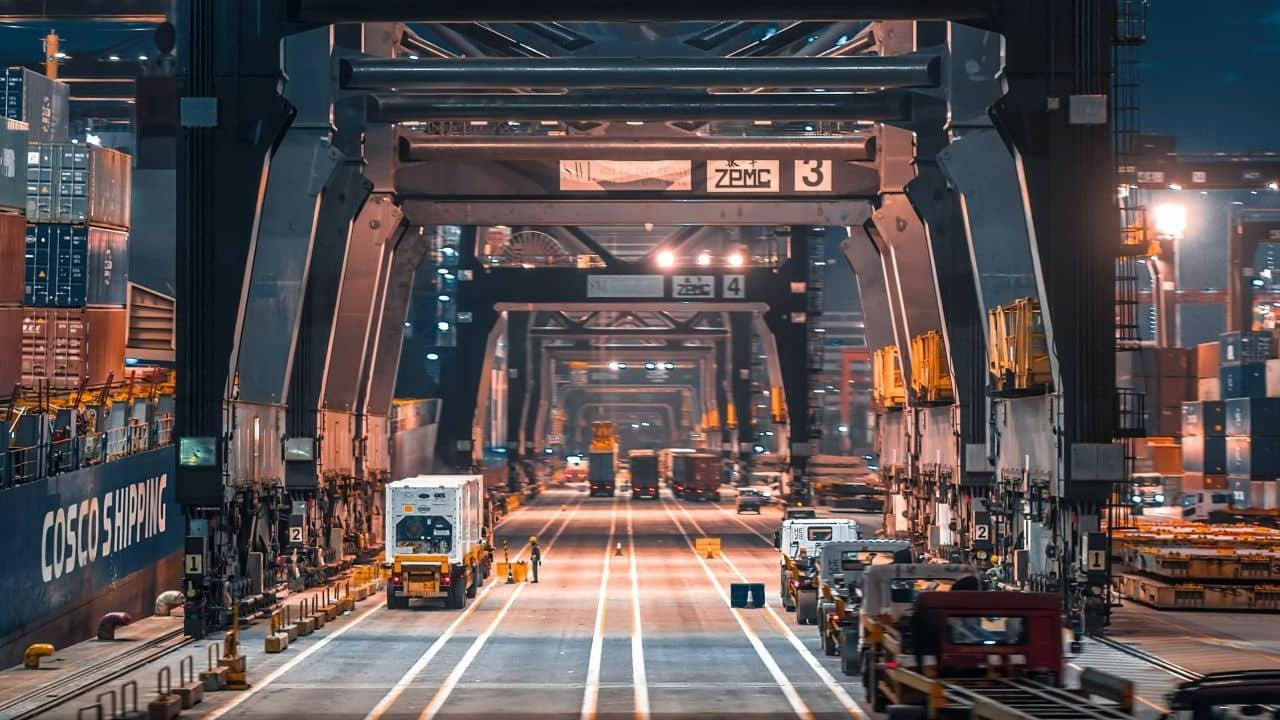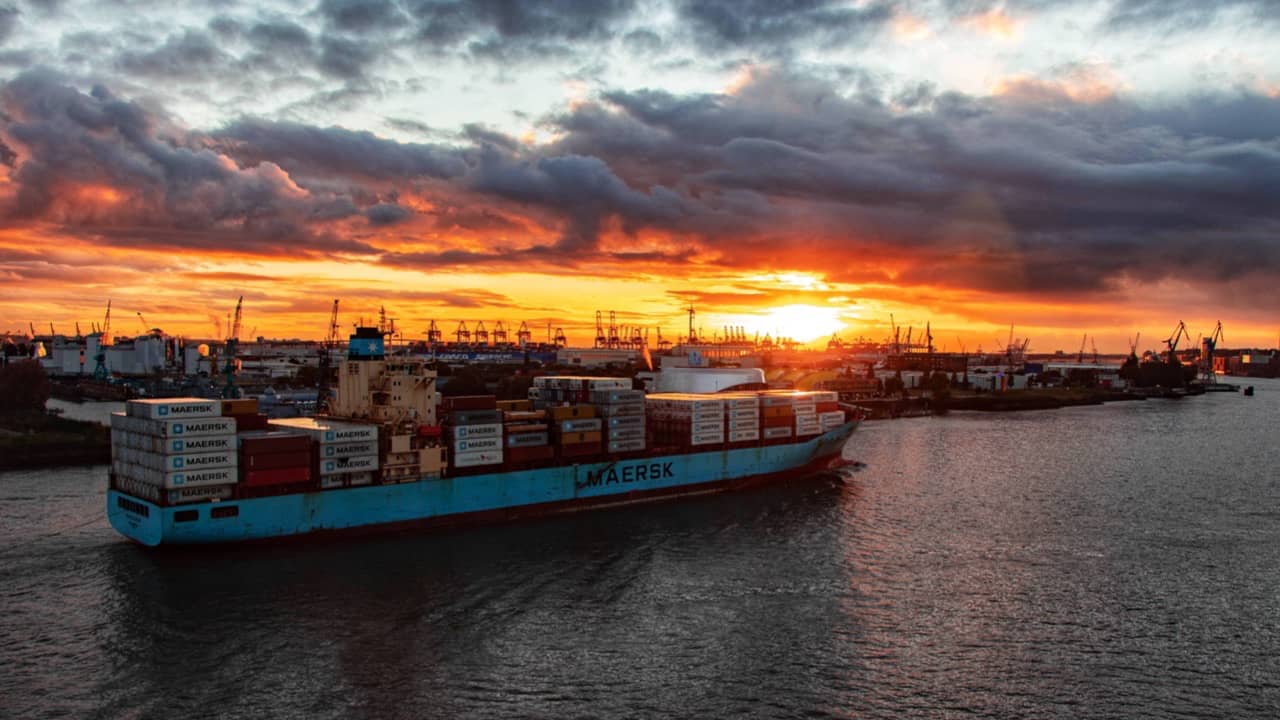
There’s Never a Boring Day in the Supply Chain
21-minute read
Learn how the soaring logistics and shipping costs feed global inflation. What do inflation, recession, and slowing global growth mean for the logistics industry?
In this extract from Lodestar’s podcast, Mike King and his guests from around the world explore the current state of play in global logistics, shipping and air cargo, covering the biggest news stories of the supply chain, including a briefing on air and ocean freight rates and the macroeconomic environment buffeting the freight industry.
Mike King: Let’s have a look at the shipping markets. Spot freight rates have been coming off all summer, haven’t they?
Mike Wackett: Yes, Xeneta’s Shipping Index (XSI) from Asia to North Europe was down another 3% this week to US$9082 per 40’ft. So far this month, that’s 10% off, and that’s 40% down since January.
On the Trans-Pacific, Xeneta’s Asia to US West Coast reading was down 1.5% this week to US$6046 for 40’ft. That’s down 13% this month and down 30% since April.
Mike King: How about contract rates? Are they turning downwards too?
Mike Wackett: Not yet. Xeneta’s long-term contract rates index peaked last month. That was up a staggering 112% year on year, but with spot rates falling in some cases lower than contract rates, carriers will likely come under increased pressure to renegotiate those contracts in the coming months.
Mike King: Obviously, we’re supposed to be coming up to peak season or more or less in the midst of it already. Are carriers doing anything to hold the slide in those rates?
Mike Wackett: Well, they are using the only tool they have, capacity management, which worked very well for them at the start of the pandemic. They see no reason to change that strategy to cope with softer demand.
So what we have at the moment is a mixture of official blank sailings and what they now call slidings, which happen when the ships are delayed by port congestion somewhere else and automatically slide into the next week or the week after.
Mike King: Obviously, those blank sailings are felt first in Asia, where a lot of this cargo is loaded, China in particular.
We’ve also seen a bit of a manufacturing slowdown in China over the summer.
We’ve had COVID shutdowns most recently in Shenzen and Tianjin after all those problems around Shanghai.
So let’s hear what the situation is like in China for forwarders and shippers.
I want to welcome Kathy Liu, a global sales and marketing director at Dimerco Express Group, a forwarding and contract logistics services provider with a strong focus on the Asia Pacific region and based in Shanghai.
From your viewpoint in China, could you explain the current demand situation there or across key Asian manufacturing centres? Are we still seeing disruptions to exports out of China due to lockdowns?
We’ve also had Chinese military exercises near Taiwan. How much disruption do we see at the moment to that export pipeline that’s so critical to global trade?

Kathy Liu: The lockdown in Shanghai during April and May this year impacted manufacturing, especially in East China. It took a couple of weeks in June to recover, but for the rest of China, we didn’t see that much of an impact.
Currently, the only impact is felt in mainland China between Shenzhen and Hong Kong because of COVID cases in Shenzhen, which are believed to have come from cross-border trucks. From July 24th, the daily number of truck permits was reduced from 3500 to 1500, a reduction of more than 50%.
We were informed that it has recovered to 80%. However, there’s still a 20% truck capacity shortage between South China Shenzhen and Hong Kong, impacting factories that move goods via Hong Kong as a gateway and needing to find other solutions within Southern China.
We have been offering ocean feeder service to keep the supply chain moving for affected customers to keep the original routing via Hong Kong.
Regarding the military exercises near Taiwan, the major impact we saw was on the air freight because almost all Chinese airlines cancelled their flights, including freighters and passenger flights around Taiwan, during the exercise.
This created a capacity shortage, but the exercise lasted only about 5-6 days, so it didn’t impact much. However, the central government hinted that the exercises might become more regular in future, so we are closely monitoring the situation.
Mike King: Obviously, the world is slightly different now with Ukraine’s invasion, and investments may be judged by the political system rather than where’s cheapest.
Many people have been predicting that we might see manufacturers sourcing more from alternatives to China or closer to home, partly due to the geopolitical tensions around Taiwan. Are you seeing anything of that in Asia at the moment?
Kathy Liu: Because of the lockdown in Shanghai and the zero COVID policy, anytime any city can be locked down by the government, so to be on the safe side, some customers moved out a certain percentage of their production to South East Asia to Vietnam and Thailand.
Mike King: Do you think that will continue in future?
Kathy Liu: I think it depends on the results. Besides manufacturing, they also need to evaluate the transportation, capacity, and quality of work.
We think that manufacturing of some low-end products has already started moving out of China, but high-tech manufacturing, like semiconductors, and electronic technology, will remain in China.
Mike King: Kathy, what’s your take on the current global economy?
The US and Europe, by most accounts, are on the brink of recession, and inflation is running rampant. How is this being viewed and acted upon in Asia, where many manufacturers depend on those markets?
Are they anticipating slowing demand? What does all of this mean for the next few months when we usually expect a significant pickup in demand for shipping peak season and then later on into the air cargo peak season?
Kathy Liu: From the beginning of this year, we are already seeing slower demand in the market, especially for the export from China to the US and Europe, due to the recession and high inflation in both of those regions, so the buying power is lower compared with years ago.
Also, for the last two years, there has been high consumer demand for laptops, printers and other electronic equipment to support working and studying from home. However, in 2022 that kind of demand is not there anymore, so we have seen a big decline in this sector.
Mike King: Have you got any product launches coming up in the next few months that might temporarily boost demand for air cargo or shipping?
Kathy Liu: Apple and Google typically have new product launches during September and October, so we expect a slight pick season for this year, maybe the second or third week of September.
Mike King: Do you expect this will boost air cargo rates? We’ve seen some capacity coming in, but rates out of China have been rather flat.
Kathy Liu: Last year, air cargo rates hit the highest record during the pandemic, but this year from January up to August, the rates are 50% lower as compared with last year’s peak season, so if the peak season comes, rates will go up but will not reach the same level as last year.
Mike King: I’m joined by Peyton Burnett, the managing director of TAC index. Where has the market price for air cargo been going for the last month?

Peyton Burnett: Generally, the markets have been either flat or softening.
Mike King: What’s your take on demand for air cargo services now? Are we still expecting a peak season, perhaps in Q4?
Peyton Burnett: I’ve been talking to shippers who tend to be more downbeat, but I can say that they seem to be rubbing their hands and feel that the market has swung away from the airlines in favour of shippers.
I would also like to add that shippers feel that the airlines could have been greedy earlier in the year by not allowing allocations to the forwarders as airlines wanted to trade in the spot market coming into the peak season. This has now swung in favour of shippers, and airlines expect a much more muted peak season this year.
Mike King: We’ve been talking on the Lodestar podcast for quite some time about how regulators and market conditions we’ve had over the last two years started focusing more on shipping and less on the supply chain issues. We’ve seen this already in the US with the ocean shipping Reform Act earlier this year.
European shippers have not been happy with the liner shipping industry for quite some time, particularly with these high prices, and they’ve been lobbying the European Commission repeatedly.
The Commission is now reviewing its consortium block exemption which essentially, in its most basic form, exempts certain cooperation agreements in the liner shipping sector from anticompetitive agreements. What happens next?
Mike Wackett: The European commissioners have finally begun reviewing the liner consortium block exemption regulation, which expires in April 2024.
It has already started with a late-week period of consultation when it will seek the views of all stakeholders.
Shippers complain that there are no benefits and many disadvantages to the exemption.
They complain that there’s a competitive advantage to carriers, that it’s far too generous and that it needs urgent reform.
Mike King: I’d like to look at the US market and welcome Jason Haith, manager at transpacific forwarding specialist OEC Group.
Can you explain if the Trans-Pacific US logistics network holding up?
Jason Haith: The West Coast is still a problem, particularly Los Angeles. Seattle isn’t much better. A lot of this has to do with the domestic rail network here in the US.
I saw a message that the Union Pacific, one of two railroads pulling cargo inland off the West Coast, is starting to stop some of the services into the Midwest so that they can regroup.
These issues are all cyclical. Suppose containers aren’t leaving the rail in, say, Chicago.
In that case, that means the rail cannot continue bringing containers in and if they can’t keep bringing containers inland, then those containers end up sitting at port facilities, congesting the ports, which slows down the inbound vessels in their processing, and around and around we go.
So even 12-18 months after the initial problem, it’s still a significant hurdle for importers in the Midwest.

Mike King: We discussed earlier in the year that you were expecting this shift away from the West Coast to the East Coast, partly because the PMA and the ILWU union agreement finished on June 30th, and there are still negotiations going on about this dock worker agreement between the two parties, but in the meantime, we’ve seen that shift of traffic on ships to the East Coast.
How did that impact your planning?
Jason Haith: It started just after Chinese New Year but picked up in April and May. People who utilized the rail in the ports on the West Coast were disgruntled that containers weren’t being processed.
With the addition of the uncertainty of that ILWU negotiation, they started making decisions to route products through the US East Coast gateways. In terms of infrastructure capacity, the East Coast gateways aren’t the same as the West Coast.
Hence, we started to see a build-up of containers in Savannah, a build-up of vessels waiting to get into Savannah, and then a build-up of vessels waiting to get into Norfolk and Charleston.
It got so bad that shipping lines were rerouting vessels away from Charleston in some instances while they were underway because there were so many containers there that truckers weren’t able to pull them out because of chassis issues.
It’s almost as if you picked up all of the problems on the West Coast last year: congestion waiting for boats to get in, congestion in the terminals, chassis and trucker shortages and plunked them down on the East Coast.
That’s exactly what they’re dealing with now. In terms of planning, it’s incredibly uncertain. The delays can add 6 to 8 weeks, in some cases unforeseen, because of these problems, so it’s challenging to address.
Mike King: Are you finding that your customers fully understand when transit times from a container loaded in China start stretching out because of problems with the port or hinterland?
How do you explain that to customers, and how bad are those problems?
Jason Haith: They can be pretty severe. The shift of container volume from the West Coast to the East Coast was substantial – 30 or 35% of that volume, we think, has moved over.
Still, containers sit at terminals for two months, 60 days, and 65 days and once they start moving inland and arrive at the rail ramps of Chicago, Kansas City or Memphis Dallas, the rail ramps are stacking containers too because there aren’t enough chassis and truckers to pull everything out on time.
It can be very difficult to explain these issues to customers. We certainly try our best to provide up-to-date maps and screenshots, but I think people are genuinely apathetic. These problems have persisted for so long and have been seemingly insurmountable irrespective of what provider they choose to go to.
It’ll be with us for at least the end of the year, and I imagine something that’s driving purchasing managers bananas.
Mike King: How exactly are they managing that? We talk a lot in our industry about inventory management, and we talk a lot about whether US retail companies know where the demand is and whether they have the right stock.
Is it getting that time of the season? What sort of problems are you hearing from your customers?
Jason Haith: I think companies are doing their best to take the delays and problems they saw last year and apply that to product lead time, thinking that hopefully, things will slowly improve and overall transit time will come down over time.
I don’t think transit times have come down. I think it may have even gone up. That’s putting importers in a tough position.
That means that seasonal product it’s not arriving when it’s supposed to. It’s not showing up to the warehouse when they need it, and if it misses the season or it’s too late to put out, they have to do something with it.
In many cases, it just sits in their warehouse, taking up space while all other products come in that they need to process.
Hence, all these issues are certainly interrelated, and improvement on one side often means some detriment on the other.
I think it’s going to be a while before the import community can get to some workable equilibrium.
The foundations of business: production lead time, transportation lead time, and warehouse turnaround time, have been completely upended and been variable over the course of the past 18 months.
Mike King: We’ve seen shipping pricing come down, certainly on Trans-Pacific trades. How are the overall supply chain and hinterland costs looking?
Do you think we’ll see more reductions in the overall cost of shipment as demand softens slightly due to inflation, the state of economies, and a possible recession? What’s your take on these things?
Jason Haith: Overall, ocean freight rates are trending down. And I think the only market force capable of achieving that is demand. The fewer shipments out there, the more competition is for the remaining.
I think that’s the position we’re headed into. Companies are reticent to place new orders and bring in new inventory because they know what’s on the horizon, and it doesn’t look all that amazing.
On the other side, we’ve seen some of the decreases in ocean freight costs offset by increases in delivery costs, particularly fuel. Not too long ago, I saw some fuel surcharges at fifty-eight per cent.
Fifty-eight per cent of the delivery was associated with fuel. It’s higher than I’ve ever seen, and truckers scrambled to cover that difference. As a result, the ocean freight portion will come down due to demand and delay.
I believe carriers will use every opportunity they can to maintain their cost advantage. They will do that by cancelling or blanking sailings, which they already do, adding to the uncertainty.
Mike King: Have you got any words of optimism for shippers going into 2023 or even the final quarter of this year?
Jason Haith: I think the only shining star is cost. People were paying exorbitant rates in 2021 for a similar service to what they’re getting now for a lower price, so from that perspective, I think that’ll be one of the benefits.
In terms of efficiency, I think we’ve still got quite a way to go before people can accurately predict transit time.

Mike King: Container lines have reported their Q2 financial results. What were your main takeaways from them?
Mike Wackett: They had record Q2 and interim H1 results and have good visibility into this current quarter. That has prompted many carriers to upgrade their outlooks. For instance, Maersk upgraded its outlook by 7 billion to 31 billion for the year.
We’re now looking at a potential industry profit for this year of 300 billion, which compares with the 200 billion last year.
However, carriers now seem nervous about the fourth quarter and onwards as some form of normalization is reached, which means their profits will be reducing. Obviously, what they’ll be trying to do is to make sure they don’t reduce too much.
Mike King: The lines have built up some big war chests. I think it’s fair to say that they’re cash rich.
Where might we see them investing some of that money?
Mike Wackett: I certainly feel that there is much more caution than before. I think they will be more inclined to sit on their hands for a while until they see how Q3 is working its way through and what the booking prospects are like for Q4.
Having said that, they got these enormous war chests. Maersk said last week that it’s something like 19 billion available to buy up as many logistics companies as they like.
We’ve seen them buying all sorts of strange and wonderful things, but obviously, there’s also the pressure to hand money back to shareholders.
Some nervousness is now creeping in as you’re only as good as your last month’s figures, so what’re the budgets looking like for 2023? Carriers don’t know, so that will make everybody nervous and put a hold on being too adventurous with their cash.
Mike King: The macroeconomic situation has taken something of a downturn this year. It’s impacting all those buying, moving and selling freight.
I’m joined by Rob Subbaraman, Nomura’s head of global macro research and co-head of global markets research.
The International Monetary Fund’s July forecasts saw some heavy downgrades compared to April’s previous forecasts.
For example, the IMF expects global trade in goods and services to expand by 4.1% this year, which is down 0.9 percentage points from April.
The IMF also drastically cut global GDP growth this year by 0.4 percentage points to 3.2% and by 0.7 percentage points for 2023 when growth is expected to be just 2.9%
The advanced economies, particularly the US and Germany, took a big hit here, with massive growth forecast reductions.
We’re talking about German GDP growth in 2023 of just 0.8%, which is 1.9 percentage points down since April.
We’ve got some seriously dark economic clouds on the horizon.
In the UK, we’ve now got double-digit inflation for the first time in 40 years, and the IMF is forecasting consumer price inflation of 8.3% in 2022.
Has Nomura been downgrading its forecast at the same rate as the IMF? Are you expecting some of these economies to turn into recession in the quarters ahead?
Rob Subbaraman: We concur with the IMF, World Bank, and other international agencies on a darkening growth outlook, but we think they haven’t cut enough. We’ve already moved into a baseline forecast of recessions in the US and Europe, and some other major economies.
I think that economists are reluctant to forecast recessions. They, generally, highlight the downside risks. They don’t like to be messengers of bad news.
When I look at what’s out there, many major economies are going to have recessions starting very soon.
The thing about these recessions is that they’re fairly mild but, importantly, long-lasting. The reason is that we don’t think central banks will come quickly to the rescue in cutting rates to revive these economies. We believe inflation will be around sticky for some time.
To give you more numbers for the US next year, we have minus 1.2% GDP, Eurozone and the UK minus 1%. Some of the countries that have had housing booms like Australia and New Zealand, Canada, and South Korea, we have them contracting as well next year.
Mike King: Do you see downside risk to some of these forecasts? Do you have any reason for optimism?
Rob Subbaraman: We are fairly balanced in forecasting recessions, so we’re more negative than the IMF, so the risks are fairly balanced.
I would say the downside risks lie in Europe and maybe some countries with housing booms that could turn into busts. In Europe, the energy crisis could have a bigger negative effect than we think, and in countries like Australia and Canada, where housing has boomed, it could be more severe.
The upside is that inflation will come down much quicker than we think. And then central banks can start to unwind the rate hikes faster than we think.
Mike King: We’ve seen headlines about recession more or less every day that rising prices create difficulties whether you’re an individual or a business. But not everyone can pass on these higher costs. However, there’s a slightly mixed picture.
Container spot rates are down. Air cargo fuel is a bit cheaper. Core materials like aluminium, plastics, iron and steel, chemicals, and copper, maybe they’re not coming down necessarily, but they’re levelling off in terms of price increases. How are you reading this?
Rob Subbaraman: What’s happened is commodity prices have come off, but the important point is that commodities do not represent the whole CPI picture. Other parts of the CPI, like housing prices, wages, and services, have a bigger weight in the CPI basket.
Inflation has already started to feed through into these areas, so we believe that even if commodity prices have come off, inflation will not come down very quickly. It’s going to be sticky, and that’s important.
The other relevant point is that central banks and, most notably, the Fed will not finish their hiking cycle until they’re confident that inflation is nearly coming back towards their 2% target. They made the mistake of letting inflation jump too high.
The lesson from the 1970s is that if you ease too early and inflation stays high, it can become a self-fulfilling prophecy where workers demand higher wages, and firms have to raise selling prices. That’s the last thing they want to happen.

Mike King: What does all this mean for our core audience, interested in global traders and expecting this to slow or drop off due to all these headwinds we see in the macroeconomic environment?
Rob Subbaraman: The short answer is yes, we think global trade will slow down going forward.
One crucial point is that it’s not just one major economy. Most of the major economies are slowing down synchronously, and when that happens, it tends to be more negative for global trade.
The other point is that during the pandemic, because of the supply chain snarls and the uncertainty, companies double or triple ordered their inventories because they didn’t want to get caught without them.
And now, with demand weakening, the risk is we’re going to have an inventory glut. Too much unintended inventory build-up tends to be negative for global trade.
So, overall, the export leading index points to a pretty significant downturn in Asian export growth in the second half of this year.
Maybe in three or four months, we could be around zero growth for Asia exports. Asia is often a bellwether for global growth, it’s the hub of manufacturing, so this is not an encouraging sign for global growth.
It is consistent with our view that many major economies are headed for recession.
Mike King: My next guest is John McCown, a container shipping veteran and founder of Blue Alpha Capital.
How have rising shipping costs impacted the US or global inflation, and how will shipping and supply chains be affected by that rising inflation?
How, in your view, the shipping costs have been feeding this inflationary monster we’re looking at right now?
John McCown: My numbers point to 82 billion for the US and 286 billion for the world in terms of the additional cost of container shipping, comparing the last quarter to two years ago before the impact.
We’ve seen overall container shipping pricing go up almost three times over the course of the pandemic.
While short-lived initially, the volume surge we saw led to a whole array of catalysts that led to congestion and bottlenecks, which transitioned or made a favourable supply-demand dynamic for carriers.
Mike King: What’s your view of the contract and spot markets? Where do you see shipping costs going in future for those in the business of buying capacity?
John McCown: The spot pricing gets much more attention than I think it deserves.
My numbers show that spot price today only impacts about 10% of the loads. If you look at the overall index, overall pricing worldwide compared to two years ago is about 2.8 times what it was then.
On average, contract pricing is up about 2.1 times, and spot pricing is up some 4.8 times.
The contract rates have continued to push up as contracts are renewed. The contracts are at least for a year, so there will be a big tail effect on these contracts. So I think we’ll see pricing stay fairly high, at least for the next two or three quarters.
Mike King: Are we talking about prolonged profits for container lines, then?
John McCown: All of the second quarter numbers aren’t in yet. I’m still waiting for a couple more carriers to report, but I can say now that it looks like it’s going to be a better second quarter than it was in the first quarter.
My numbers are circling at about 65 billion net income, which is about 11% more than the 59 billion they made in the first quarter.
So to put that into perspective, that’s the seventh straight quarter that the container shipping industry has had a record net income. That’s a staggering turnaround, most notably for an industry that for 10 years was bumping along break even.
But again, it’s all related to this supply-demand dynamic driven by congestion and bottlenecks worldwide.
Mike King: What, in your view, changes that supply-demand dynamic? Will container lines keep space tight for as long as possible with blank or void sailings?
What does that mean for people shipping, and should they expect increased rates and costs for an extended period, let’s say two years, three years, or four years?
John McCown: Well, we have an unusually high number of ships being ordered, so that capacity will come on, which could have a moderating effect.
The congestion will work through the system, and we’re seeing many signs where it’s improving, which will return capacity. But I anticipate we’ll see more action by the carriers by cancelling sailings. Otherwise, I don’t think they’ll be able to maintain their supply-demand dynamic.
The tool of blanking sailings was much more effective than the carriers thought at the beginning of the pandemic when there was volume shock on the downside. So I anticipate we’ll see a bit more of that.
The supply chain used to run like clockwork. You could pick the hour a load that was moved halfway across the world would arrive. And now you can’t even pick the week. That’s going to lead companies to potentially nearshoring.
So there are a lot of moving pieces, but I don’t think we’ll see a continuation of the extraordinary earnings.

Mike King: This year, we’ve seen fuel costs shoot up, significantly impacting freight and shipping costs. How does this inflation impact the supply chain and shipping strategies more generally?
John McCown: Fuel cost is typically the largest cost related to the vessel. In theory, carriers have a fuel surcharge mechanism that works or has a goal of passing that cost on. In reality, sometimes, depending on the market conditions, it can have an exacerbating or even the opposite effect.
The more significant point to remember is that in container shipping, the ship itself and its costs are a relatively small part of the overall cost that the carrier takes, often little more than 1/3 of their call. Carriers also have cargo handling, terminal handling, equipment, and other costs.
One of the things that fascinated me is that even with the threefold increase in pricing, we haven’t seen any dent in the actual cargo volume. That’s a striking observation of reality.
If you saw that kind of increase in other sectors, you would see an impact and perhaps a major falloff in volume. The fact that carriers haven’t seen a drop in volume probably gives them more support, thinking they can raise prices with the comfort of knowing it will not impact the volume.
Mike King: Is it possible that the inelasticity of pricing we’ve seen is a short-term trend simply because people haven’t had any choice?
John McCown: We’ve had unusually high growth in volume continuous for the last 24 months. In the US, many ports have been operating at effectively full capacity, which has minimized the seasonal swings. However, I don’t see any falloff right now from that pricing.
It’s a bit of a reminder that container shipping will continue to grow. One of the constants we can expect in container shipping is that volume will grow as the population grows because it is based on consumption.
So that’s going to drive a need for a lot of infrastructure investment. The issue is really at the terminals and beyond. In the US, we have the same terminal structure we’ve had for decades, so there’s a need for new terminals and processes.
Mike King: You mentioned nearshoring a few times. We’ve seen war in Ukraine and rising tensions with China over Taiwan.
Companies may not move manufacturing out of China immediately, but will this influence their next investments?
How does that affect, in your view, the shipping market and demand?
John McCown: Not as much, perhaps, as people think.
When the tariff war occurred, much of the products coming from China had 20 to 25% tariff applied, and the majority of products initially did see some falloff, and there was some switching to Vietnam and Thailand. I think when that initially happened, people were looking at alternatives.
Looking at the volume coming out of China, you’re far-pressed to see the continuing impact of the tariff. It added 20 or 25% effectively to the price of goods. Corporations looked to see if there were alternatives. However, they went back to China to have the volume and the same cost.
There are certainly tensions with China, but the two countries have an extraordinary business relationship. The amount of trade China and the US do is undoubtedly a nice mitigating factor for these tensions.
As to your other point in terms of Ukraine, that isn’t having much of a noticeable impact on container lines, as Russia isn’t a meaningful player in that.
Container shipping has shown its ability to keep moving, and again it returns to that extraordinary efficiency, which reduced, if not largely eliminated, the barrier of location.
Source: The Loadstar podcast. This interview was edited for clarity.
P.S. Easy Freight Ltd helps New Zealand importers & exporters to save money on international freight and reduce mistakes by guiding how to comply with Customs and biosecurity rules.
➔ Contact us now to learn how we can assist you.
